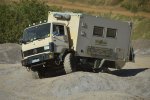Noted on Alum-line. My hope is they will build what I want and ship it to me for mounting. I'll check out Highway Products for sure. I keep holding out hope to find a good used unit here in Utah. I already have an Aussie style "ute" shell made by that I would keep on the flatbed when not in camper mode. Those ARE shells are sort of fragile and my hope is the flex mount will keep it together. I really think flatbeds should all be mounted this way and I'm shocked it's been this hard to find somebody who can do it.
Fingers crossed for Alum-line. They seem to make a great product. I had called in April so maybe they just had corona-brain...
I saw my first Euro-style camper almost 15 years ago and it seemed like such good formula: composite construction, flat floor, dynamic mounting. I figured that by the time I was going to get into one, the US marketplace would have it figured out. ?





